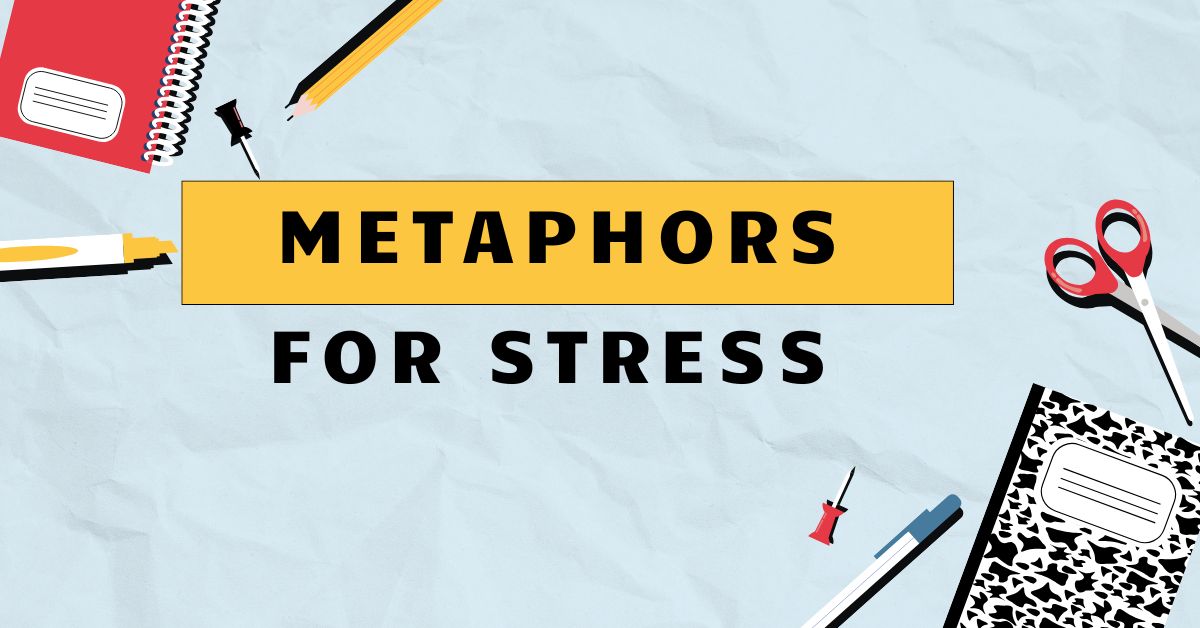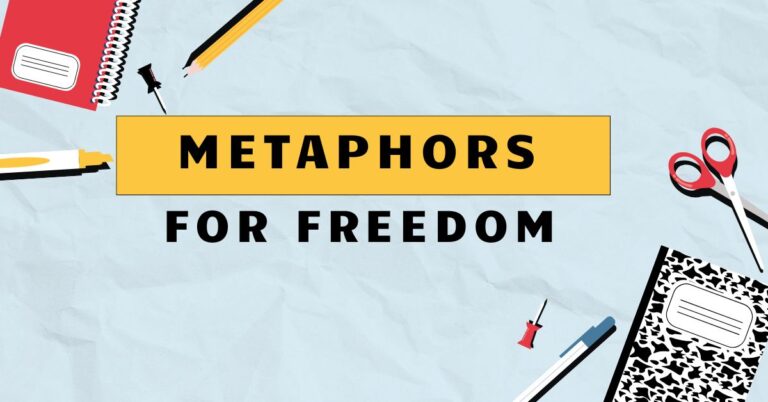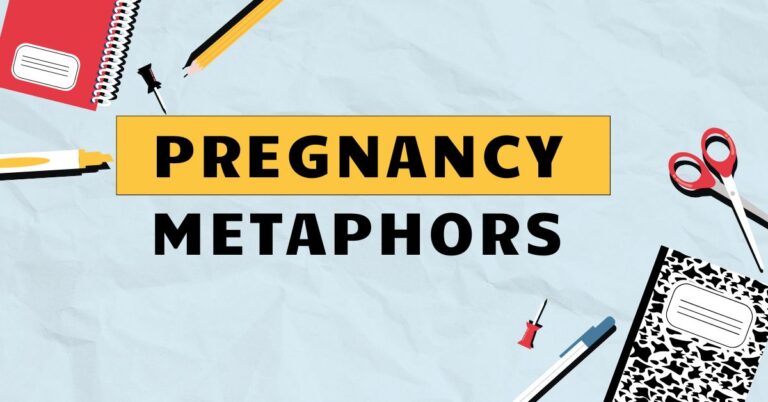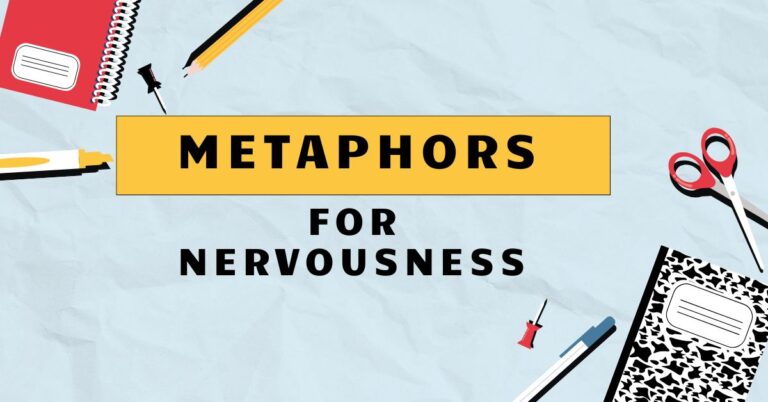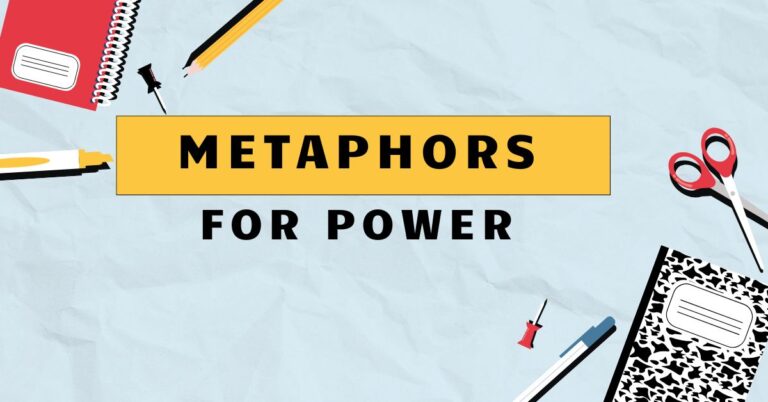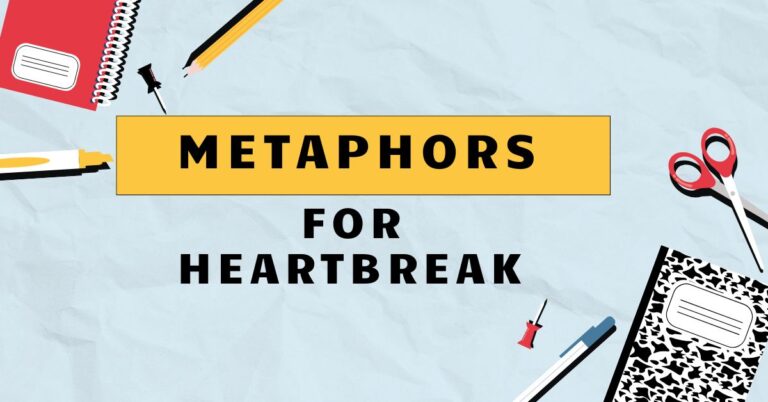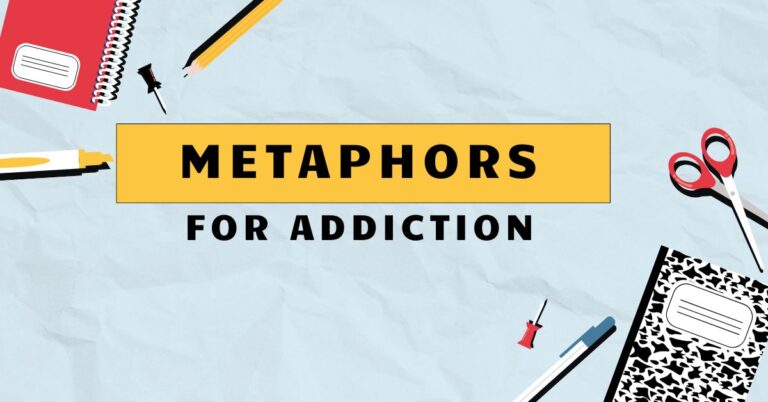41 Metaphors for Stress: Understanding Figurative Language
Understanding how we use metaphors to describe stress is crucial for both effective communication and emotional intelligence. Metaphors allow us to express complex feelings and experiences in relatable and vivid ways.
This article explores the various metaphors used to depict stress, their grammatical structures, and how they enhance our understanding of this common human experience. This guide is perfect for English language learners, writers, therapists, and anyone interested in deepening their grasp of figurative language.
Table of Contents
- Introduction
- Definition of Metaphor for Stress
- Structural Breakdown of Stress Metaphors
- Types and Categories of Stress Metaphors
- Examples of Metaphors for Stress
- Usage Rules for Stress Metaphors
- Common Mistakes with Stress Metaphors
- Practice Exercises
- Advanced Topics in Stress Metaphors
- Frequently Asked Questions
- Conclusion
Definition of Metaphor for Stress
A metaphor for stress is a figure of speech that describes stress by comparing it to something else, without using “like” or “as.” It allows us to understand and communicate the abstract concept of stress through more concrete and relatable terms. Metaphors help us express the intensity, effects, and nature of stress in a vivid and impactful way.
In essence, a metaphor operates by transferring qualities from one thing (the source domain) to another (the target domain). In the case of stress metaphors, the target domain is the feeling or state of stress, and the source domain can be anything from physical burdens to natural disasters.
This transfer allows us to conceptualize stress in more tangible terms, making it easier to understand and articulate.
The function of a metaphor for stress is multifaceted. Firstly, it enhances communication by providing a shared understanding of a subjective experience.
Secondly, it can deepen our self-awareness by prompting us to reflect on the specific qualities of stress we are experiencing. Lastly, it can offer a new perspective on stress, potentially leading to more effective coping strategies.
For example, if we view stress as a “storm,” we might be more inclined to seek shelter and wait for it to pass.
Structural Breakdown of Stress Metaphors
The structure of a stress metaphor typically involves two key elements: thetenorand thevehicle. The tenor is the subject being described (in this case, stress), while the vehicle is the object or concept to which stress is being compared.
The connection between the tenor and vehicle is theground, which refers to the shared characteristics or qualities that make the comparison meaningful.
Consider the metaphor: “Stress is a heavy burden.” Here, “stress” is the tenor, “a heavy burden” is the vehicle, and the ground is the feeling of being weighed down or overwhelmed. The effectiveness of a metaphor depends on how well the vehicle captures the essence of the tenor.
A strong metaphor resonates with the audience, evoking a clear and vivid image of the experience being described.
Metaphors can be expressed using various grammatical structures, including nouns, verbs, and adjectives. For example:
- Noun: “Stress is a monster.”
- Verb: “Stress consumes me.”
- Adjective: “I feel drained by stress.”
Understanding these structural elements allows us to analyze and appreciate the nuances of stress metaphors, as well as to create our own compelling figurative language.
Types and Categories of Stress Metaphors
Stress metaphors can be categorized based on the specific imagery and concepts they employ. Here are some common categories:
Stress as Weight
This category portrays stress as a physical burden that weighs us down, making it difficult to move forward. It emphasizes the feeling of being overwhelmed and burdened by responsibilities or problems.
Stress as Pressure
Here, stress is likened to an external force that is squeezing or compressing us. This highlights the feeling of being under constant pressure to perform or meet expectations, often leading to a sense of being overwhelmed and suffocated.
Stress as Attack
This type of metaphor depicts stress as an aggressive force that is attacking or harming us. It emphasizes the feeling of being under threat and the damaging effects of stress on our physical and mental health.
Stress as Weather
This category uses weather phenomena to describe the experience of stress, such as storms, clouds, or fog. It highlights the unpredictable and overwhelming nature of stress, as well as its ability to obscure our clarity and well-being.
Stress as Container
This type of metaphor uses the concept of a container to describe how stress can build up and become overwhelming. It emphasizes the feeling of being filled to the brim and the potential for things to spill over or explode.
Stress as Battle
This category frames stress as a conflict or struggle, often involving opposing forces. It emphasizes the feeling of being in a constant fight against stressors and the toll it takes on our energy and resources.
Stress as Physical Affliction
This type of metaphor likens stress to an illness or injury, highlighting its detrimental effects on our physical and mental health. It emphasizes the pain, discomfort, and limitations caused by stress.
Examples of Metaphors for Stress
The following tables provide extensive examples of metaphors for stress, organized by category:
Table 1: Stress as Weight
This table illustrates metaphors that compare stress to physical burdens, emphasizing the feeling of being weighed down.
| Metaphor | Explanation |
|---|---|
| Stress is a heavy burden. | Stress feels like a physical weight that is difficult to carry. |
| I’m carrying the weight of the world on my shoulders. | Feeling responsible for everything and everyone. |
| The pressure at work is a ton of bricks. | The workload feels overwhelmingly heavy. |
| I feel weighed down by my responsibilities. | Responsibilities are felt as a heavy load. |
| Stress is like a lead blanket. | Stress feels heavy and suffocating. |
| I’m drowning in responsibilities. | Feeling overwhelmed by the number of things to do. |
| The workload is a mountain to climb. | The amount of work seems insurmountable. |
| Stress is a heavy anchor holding me back. | Stress prevents progress and forward movement. |
| I’m carrying a lot of baggage. | Emotional burdens and past traumas are felt as weight. |
| The stress is a boulder I can’t move. | Stress feels like an immovable obstacle. |
| My worries are a heavy backpack. | Anxieties feel like a constant, cumbersome weight. |
| Stress is a concrete block tied to my feet. | Stress significantly hinders movement and progress. |
| I’m lugging around a sack of worries. | Anxieties and concerns are felt as a cumbersome load. |
| The demands of my job are a heavy toll. | Job requirements feel like a significant burden. |
| Stress is a chain that binds me. | Stress restricts freedom and movement. |
| I’m dragging my feet through the day. | Feeling extremely burdened and unmotivated. |
| The weight of expectations is crushing me. | Feeling overwhelmed by the pressure to meet expectations. |
| Stress is a yoke around my neck. | Stress feels like a heavy burden that restricts movement. |
| I’m carrying the burden of their mistakes. | Feeling responsible for the errors of others. |
| The stress is a millstone around my neck. | Stress feels like a heavy and inescapable burden. |
| Stress is like carrying a soaked mattress. | Stress feels heavy, cumbersome, and difficult to manage. |
| I feel like Atlas, holding up the world. | Feeling an immense and overwhelming responsibility for everything. |
| The stress is just dead weight I need to shed. | Stress feels like an unnecessary burden that must be eliminated. |
Table 2: Stress as Pressure
This table showcases metaphors that describe stress as an external force, highlighting the feeling of being squeezed or compressed.
| Metaphor | Explanation |
|---|---|
| I’m feeling the pressure. | Experiencing stress due to demands and expectations. |
| I’m under a lot of pressure. | Being subjected to intense demands and expectations. |
| The pressure is mounting. | Stress is increasing and becoming more intense. |
| I feel squeezed by deadlines. | Deadlines are creating a feeling of being compressed. |
| I’m cracking under the strain. | Approaching a breaking point due to stress. |
| I’m feeling the heat. | Experiencing pressure and scrutiny. |
| The walls are closing in on me. | Feeling trapped and overwhelmed by circumstances. |
| I’m walking on eggshells. | Feeling the need to be extremely cautious to avoid conflict or mistakes. |
| I’m being pulled in too many directions. | Feeling pulled apart by competing demands. |
| I’m at my breaking point. | Reaching the limit of one’s ability to cope with stress. |
| I’m feeling the squeeze. | Experiencing pressure and constraint. |
| The stress is a vise tightening around me. | Stress feels like an increasingly restrictive and painful force. |
| I’m being crushed by expectations. | Feeling overwhelmed by the pressure to meet expectations. |
| I’m running out of room to breathe. | Feeling suffocated by stress and responsibilities. |
| The demands are a weight pressing down on me. | Requirements feel like a heavy and oppressive burden. |
| I’m stretched too thin. | Feeling overextended and unable to meet all demands. |
| The pressure is building up inside. | Stress is accumulating and becoming more intense internally. |
| I’m feeling the strain of responsibility. | Experiencing stress due to the burdens of responsibility. |
| The job is a pressure cooker. | The work environment is highly stressful and intense. |
| I’m feeling the pinch of financial stress. | Experiencing financial difficulties as a form of pressure. |
| The stress is like a tightening knot in my stomach. | Stress manifests as a physical sensation of tension and discomfort. |
| I’m trapped in a pressure chamber. | Feeling confined and overwhelmed in a highly stressful environment. |
| The demands are like a constant barrage. | Requirements feel like an unrelenting and overwhelming assault. |
Table 3: Stress as Attack
This table illustrates metaphors that portray stress as an aggressive force, highlighting the feeling of being under threat.
| Metaphor | Explanation |
|---|---|
| Stress is attacking me. | Stress feels like an aggressive force. |
| Stress is consuming me. | Stress is gradually destroying one’s well-being. |
| Stress is eating away at me. | Stress is gradually eroding one’s mental and physical health. |
| Stress is a monster. | Stress feels like a terrifying and destructive force. |
| Stress is a thief stealing my joy. | Stress is robbing one of happiness and contentment. |
| I’m besieged by worries. | Feeling surrounded and attacked by anxieties. |
| I feel assaulted by deadlines. | Deadlines feel like an aggressive and overwhelming attack. |
| Stress is a venom coursing through my veins. | Stress feels like a toxic substance affecting one’s well-being. |
| Stress is a silent killer. | Stress is a dangerous and insidious threat to one’s health. |
| I’m under siege. | Feeling surrounded and attacked by stressors. |
| Stress is a fire burning me out. | Stress feels like a destructive force that is depleting one’s energy. |
| Stress is a constant barrage. | Stress feels like an unrelenting and overwhelming assault. |
| I’m being ambushed by anxieties. | Feeling suddenly overwhelmed by unexpected anxieties. |
| Stress is a parasite draining my energy. | Stress feels like a destructive force that is depleting one’s energy. |
| I’m fighting a losing battle against stress. | Feeling that one is unable to overcome stress despite efforts. |
| Stress is a predator stalking me. | Stress feels like a constant and menacing threat. |
| Stress is a plague infecting my life. | Stress is spreading and negatively impacting various aspects of life. |
| I’m being bombarded with demands. | Feeling overwhelmed by a constant stream of requirements. |
| Stress is a dark cloud hanging over me. | Stress feels like an oppressive and ominous presence. |
| I’m drowning in a sea of stress. | Feeling overwhelmed and unable to cope with the amount of stress. |
| Stress is a swarm of bees buzzing around my head. | Stress feels like a constant, irritating, and overwhelming presence. |
| I feel like stress is chipping away at my sanity. | Stress is gradually eroding one’s mental stability and well-being. |
| Stress is a relentless tide pulling me under. | Stress feels like an unstoppable force dragging one into despair. |
Table 4: Stress as Weather
This table presents metaphors that use weather phenomena to describe stress, highlighting its unpredictable and overwhelming nature.
| Metaphor | Explanation |
|---|---|
| I’m weathering a storm. | Experiencing a difficult and stressful period. |
| Stress is a dark cloud hanging over me. | Stress feels like an oppressive and ominous presence. |
| I’m in the eye of the storm. | Experiencing a brief period of calm amidst chaos. |
| Stress is a whirlwind. | Stress feels chaotic and overwhelming. |
| I feel foggy-headed from stress. | Stress is clouding one’s thinking and clarity. |
| Stress is a hurricane in my life. | Stress feels like a destructive and chaotic force. |
| The pressure is like a thunderstorm. | The pressure feels intense and overwhelming. |
| I’m snowed under with work. | Feeling overwhelmed by the amount of work. |
| Stress is a heatwave. | Stress feels intense and oppressive. |
| I’m drowning in a sea of stress. | Feeling overwhelmed and unable to cope with the amount of stress. |
| Stress is a drizzle that never stops. | Stress feels like a constant and persistent annoyance. |
| I’m caught in a downpour of demands. | Feeling overwhelmed by a sudden and intense influx of requirements. |
| Stress is a blizzard of obligations. | Stress feels like a chaotic and overwhelming accumulation of responsibilities. |
Table 5: Stress as Container
This table displays metaphors that use the concept of a container to describe how stress can build up and become overwhelming.
| Metaphor | Explanation |
|---|---|
| I’m full of stress. | Feeling completely overwhelmed and saturated with stress. |
| I’m bottling up my emotions. | Suppressing and containing one’s feelings. |
| I’m at my limit. | Reaching the maximum capacity for handling stress. |
| I’ve reached my breaking point. | Arriving at the point where one can no longer cope with stress. |
| I’m overflowing with stress. | Feeling overwhelmed and unable to contain one’s stress. |
| I’m about to burst. | Reaching the point where one’s emotions are about to explode. |
| I’m stuffed with anxiety. | Feeling completely filled with anxiety and worry. |
| My stress bucket is full. | Reaching the maximum capacity for handling stress. |
| I’m a pressure cooker about to explode. | Feeling intense pressure and about to lose control. |
| I’m filled to the brim with stress. | Feeling completely overwhelmed and saturated with stress. |
Usage Rules for Stress Metaphors
When using metaphors for stress, it’s important to ensure clarity, relevance, and appropriateness. Here are some guidelines:
- Clarity: The metaphor should be easily understood by the audience. Avoid obscure or overly complex comparisons.
- Relevance: The metaphor should accurately reflect the experience of stress. Choose imagery that resonates with the specific qualities of stress you are trying to convey.
- Appropriateness: The metaphor should be suitable for the context and audience. Avoid using metaphors that are offensive, insensitive, or trivializing.
- Consistency: Maintain consistency within the metaphor. Avoid mixing different metaphors that create conflicting images.
- Originality: While common metaphors can be effective, strive to create original and imaginative comparisons that capture the unique nuances of stress.
For example, instead of saying “Stress is bad,” a more effective metaphor might be “Stress is a relentless tide pulling me under,” which vividly conveys the feeling of being overwhelmed and helpless.
Common Mistakes with Stress Metaphors
Here are some common mistakes to avoid when using metaphors for stress:
1. Mixed Metaphors: Combining two or more metaphors that create a confusing or contradictory image.
| Incorrect | Correct |
|---|---|
| The stress is a heavy burden, but I’m sailing through it. | The stress is a heavy burden weighing me down. |
| The stress is a monster, but I’m nipping it in the bud | The stress is a monster consuming me. |
2. Clichéd Metaphors: Using overused and unoriginal metaphors that lack impact.
| Clichéd | Original |
|---|---|
| Stress is a headache. | Stress is a swarm of bees buzzing around my head. |
| Stress is a pain. | Stress is a relentless tide pulling me under. |
3. Inappropriate Metaphors: Using metaphors that are insensitive or trivializing.
| Inappropriate | Appropriate |
|---|---|
| Stress is a walk in the park. | Stress is a heavy burden to carry. |
| Stress is no big deal. | Stress is a silent killer. |
Practice Exercises
Exercise 1: Identify the Metaphor
Identify the metaphor for stress in each sentence.
| Question | Answer |
|---|---|
| 1. The pressure at work is a ton of bricks. | a ton of bricks |
| 2. I’m drowning in responsibilities. | drowning |
| 3. Stress is a monster. | a monster |
| 4. I’m weathering a storm. | weathering a storm |
| 5. I’m at my breaking point. | breaking point |
| 6. Stress is eating away at me. | eating away at me |
| 7. I feel like I’m carrying the weight of the world on my shoulders. | weight of the world on my shoulders |
| 8. The demands are a constant barrage. | a constant barrage |
| 9. My stress bucket is full. | stress bucket is full |
| 10. I’m snowed under with work. | snowed under |
Exercise 2: Create a Metaphor
Create a metaphor for stress based on the given category.
| Category | Your Metaphor |
|---|---|
| Weight | Stress is like carrying a backpack full of rocks. |
| Pressure | Stress is like being trapped in a shrinking room. |
| Attack | Stress is a swarm of locusts devouring my crops. |
| Weather | Stress is like a thick fog that blinds me. |
| Container | Stress is like a balloon that’s about to pop. |
| Battle | Stress is like fighting a war on multiple fronts. |
| Physical Affliction | Stress is like a throbbing headache that never goes away. |
| Animal | Stress is like a snake coiling around my chest, constricting my breath. |
| Machine | Stress is like an engine running on fumes, about to break down. |
| Natural Disaster | Stress is like an earthquake, shaking the foundations of my life. |
Exercise 3: Correct the Mixed Metaphor
Correct the mixed metaphor in each sentence.
| Incorrect | Correct |
|---|---|
| 1. The stress is a heavy burden, but I’m swimming through it. | The stress is a heavy burden weighing me down. |
| 2. The stress is a monster, but I’m jumping over it. | The stress is a monster consuming me. |
| 3. The stress is a dark cloud, but I’m climbing the ladder. | The stress is a dark cloud hanging over me. |
| 4. Stress is a fire, but I’m surfing through it. | Stress is a fire burning me out. |
| 5. The stress is a ton of bricks, but I’m jumping high. | The stress is a ton of bricks crushing me. |
| 6. The stress is an ocean, but I’m driving through it. | The stress is an ocean engulfing me. |
| 7. I am a pressure cooker that is swimming. | I am a pressure cooker about to explode. |
| 8. I am weathering a storm that is nipping at my heels. | I am weathering a storm that is battering me. |
| 9. Stress is a spiderweb that I am flying over. | Stress is a spiderweb trapping me. |
| 10. Stress is a dragon that I am skipping through. | Stress is a dragon consuming me. |
Advanced Topics in Stress Metaphors
For advanced learners, exploring the cultural and psychological dimensions of stress metaphors can be insightful. Different cultures may use different metaphors to describe stress, reflecting their unique values and experiences.
For example, some cultures may emphasize the social aspects of stress, while others may focus on the individual’s internal experience.
Psychologically, the metaphors we use for stress can influence our coping strategies. If we view stress as a “battle,” we might adopt a more combative and aggressive approach to dealing with it.
Conversely, if we view stress as a “storm,” we might be more inclined to seek shelter and wait for it to pass. Understanding these connections can help us choose more effective and adaptive coping mechanisms.
Furthermore, the study of metaphors in literature and rhetoric can provide a deeper appreciation of their power and impact. Analyzing how authors and speakers use stress metaphors can enhance our understanding of their message and their ability to connect with their audience.
Frequently Asked Questions
Q1: What is the difference between a metaphor and a simile?
A metaphor compares two things directly without using “like” or “as,” while a simile uses “like” or “as” to make the comparison. For example, “Stress is a monster” (metaphor) vs.
“Stress is like a monster” (simile).
Q2: Why are metaphors useful for describing stress?
Metaphors allow us to express the abstract and subjective experience of stress in more concrete and relatable terms. They help us communicate the intensity, effects, and nature of stress in a vivid and impactful way.
Q3: Can metaphors for stress be harmful?
Yes, if they are clichéd, mixed, or inappropriate. Clichéd metaphors lack impact, mixed metaphors create confusion, and inappropriate metaphors can be insensitive or trivializing.
Q4: How can I create more original metaphors for stress?
By exploring different categories of imagery, such as nature, animals, or machines, and by focusing on the specific qualities of stress you are trying to convey. Consider your personal experiences and observations to create unique and meaningful comparisons.
Q5: Are there cultural differences in the metaphors used for stress?
Yes, different cultures may use different metaphors to describe stress, reflecting their unique values and experiences. These differences can provide insights into cultural perspectives on stress and coping.
Q6: How do the metaphors we use for stress affect our coping strategies?
The metaphors we use for stress can influence our coping strategies by shaping our perception of stress. For example, viewing stress as a “battle” might lead to a more combative approach, while viewing it as a “storm” might encourage seeking shelter.
Q7: What is the role of context in using metaphors for stress?
Context is crucial in using metaphors for stress. The appropriateness and effectiveness of a metaphor depend on the audience, the purpose of communication, and the specific situation being described.
Always consider the context to ensure that the metaphor is relevant and impactful.
Q8: How can understanding stress metaphors help in therapy?
Understanding stress metaphors can help therapists gain insights into their clients’ experiences of stress. By exploring the metaphors clients use, therapists can better understand their perceptions, coping strategies, and emotional responses to stress.
This can facilitate more effective communication and therapeutic interventions.
Q9: Can the same situation cause different stress metaphors in different people?
Yes, the same situation can evoke different stress metaphors in different people based on their individual experiences, personalities, and cultural backgrounds. This variability highlights the subjective nature of stress and the importance of personalized coping strategies.
Q10: How can I improve my understanding and use of metaphors in general?
By reading widely, paying attention to the metaphors used by others, and practicing creating your own metaphors. Analyze the effectiveness of different metaphors and consider how they shape your understanding of the world.
Experiment with different categories of imagery and strive for originality and clarity.
Conclusion
Mastering metaphors for stress is a valuable skill for effective communication and emotional understanding. By understanding the structural elements, categories, and usage rules of stress metaphors, you can express your feelings more vividly and connect with others on a deeper level.
Avoid common mistakes like mixed metaphors and clichés, and strive to create original and relevant comparisons that capture the unique nuances of stress.
Remember to practice identifying and creating stress metaphors, and to consider the cultural and psychological dimensions of figurative language. By continuously expanding your knowledge and skills, you can become a more effective communicator and a more empathetic listener.
The key takeaway is that metaphors are powerful tools for understanding and expressing the complex experience of stress.

